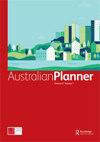Planning for tiny houses
IF 1.2
Q2 Social Sciences
引用次数: 4
Abstract
ABSTRACT The tiny house movement is an emerging trend towards building very small houses. It originated in the United States of America in the late 1990s, largely in response to housing affordability issues and a desire to live more sustainably. It is increasingly popular in Australia yet remains a niche market largely due to non-recognition within planning schemes and inconsistent local laws. Nonetheless, tiny houses could address some pressing urban housing problems, such as housing affordability and energy inefficiencies of poorly designed, large suburban houses. This paper reports on the development of the Tiny House Planning Resource for Australia, 2017, a collaborative report aimed at assisting planners, policy makers and the wider community to better understand the emerging tiny house movement and the model’s potential to contribute to greater choice in housing supply and diversity. It uses a case study focussing on South East Queensland (SEQ) to explore councils’ appetite and readiness regarding some tiny house options. It concludes tiny houses have significant potential to be a catalyst for infill development in the ‘missing middle’, either as tiny house villages, or by altering land use planning frameworks to allow both homeowners and tenants to situate well designed tiny houses on suburban lots.微型房屋的规划
微型住宅运动是一种建造非常小的房屋的新兴趋势。它起源于20世纪90年代末的美国,主要是为了应对住房负担能力问题和对更可持续生活的渴望。它在澳大利亚越来越受欢迎,但仍然是一个小众市场,主要原因是规划方案不认可和当地法律不一致。尽管如此,微型住宅可以解决一些紧迫的城市住房问题,比如住房负担能力和设计糟糕的大型郊区住宅的能源效率低下。本文报告了2017年澳大利亚微型住宅规划资源的发展,这是一份合作报告,旨在帮助规划者、政策制定者和更广泛的社区更好地了解新兴的微型住宅运动,以及该模式在住房供应和多样性方面的潜力。它以昆士兰东南部(SEQ)为例,探讨了议会对一些微型房屋选择的兴趣和准备情况。它的结论是,微型房屋具有巨大的潜力,可以作为“缺失的中间”的填充开发催化剂,无论是作为微型房屋村庄,还是通过改变土地使用规划框架,允许房主和租户在郊区的地块上建造精心设计的微型房屋。
本文章由计算机程序翻译,如有差异,请以英文原文为准。
求助全文
约1分钟内获得全文
求助全文

 求助内容:
求助内容: 应助结果提醒方式:
应助结果提醒方式:


